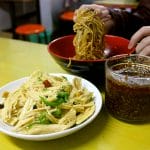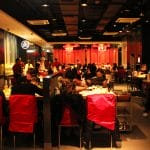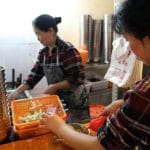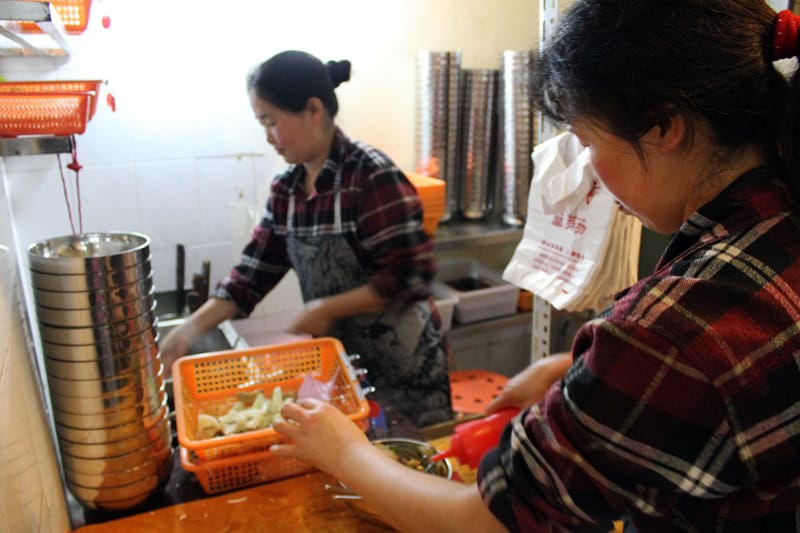[Editor’s note: We’re sorry to report that Bamboo Sichuan has closed.] The temperature has officially fallen off the register, and there are days when Shanghai seems bleak indeed, the cumulus clouds of winter hugging the skyline uncomfortably close. It’s times like these when we look to western China for inspiration, and nothing but Sichuanese-style roasted fish (四川烤鱼, sìchuān kǎo yú) will do to lift the spirits and drive away the bleary stagnations of cold, wet weather.
This dish is common in Chengdu, the heart of Sichuan and an undisputed food center of the Middle Kingdom. Located in the Red Basin and hemmed in by imposing peaks that wander towards the Himalayan foothills, this cheerful culinary capital – much like Shanghai – in December boasts an icy humidity that seeps into the joints and refuses to leave. Meals involving copious amounts of chilies and other, more physical heat sources are necessary. (Of course, when sultry summer hits, the same Chengdu residents eat even more chilies to beat the soaring temperatures … go figure.)
But, oh, that roasted fish. Authentic versions are difficult to find in Shanghai, where palates tend to prefer the sweet and mild. This dish is at its best when eaten at the long-surviving Bamboo Sichuan Restaurant (竹屋川菜馆, zhúwū chuāncài guǎn), where the waiters speak in the flowing tones of their hometown and the air is thick with chili-laced smoke.
First, choose your fish. Offerings change depending on season, but there are usually about four choices, with prices quoted by the jin (1/2 kilo). Currently, our favorite is the snakehead fish (黑鱼, hēiyú), which is mid-priced, with firm, upstanding flesh and a gentle flavor, but even a common catfish (鲶鱼, niányú) benefits from this treatment. You want a species with subtle personality, able to both stand up to and absorb the onslaught of flavor it is about to receive. A party of two will want to request a smaller fish – and even so, it will still make for a feast. Then, choose your cooking method. Go for málà (麻辣) – the original, spicy and numbing. After one unfortunate experience (pickled vegetable), we’ve learned never to deviate from the traditional path.
The fish is brought to the table wriggling and jumping for the final price quote before it’s toted off upstairs. Many Chinese, inherently suspicious of what they can’t see, will follow to make sure the kitchen doesn’t switch the fish. We have followed a couple of times – which makes for an interesting experience – but we’ve been coming here for five years, and we’ve never felt cheated.
 Split down the middle and its viscera removed, the fish is scorched over coals so the skin takes on a blackened crispness. The whole is finally submerged in a large, rectangular silver tray filled with a bubbling mélange: soup and chili oil, plus chunks of onion, celery, leeks and long tendrils of tofu skin. At least three different types of chili peppers (pickled cherry peppers, dry-fried chili peppers and fresh red chilies) add piquant depth, along with sprigs of Sichuan peppercorn, the spice for which the region is famous.
Split down the middle and its viscera removed, the fish is scorched over coals so the skin takes on a blackened crispness. The whole is finally submerged in a large, rectangular silver tray filled with a bubbling mélange: soup and chili oil, plus chunks of onion, celery, leeks and long tendrils of tofu skin. At least three different types of chili peppers (pickled cherry peppers, dry-fried chili peppers and fresh red chilies) add piquant depth, along with sprigs of Sichuan peppercorn, the spice for which the region is famous.
The dish is then brought to the table, burbling over a bed of coals, seemingly live and seething red. That’s it. Chopsticks at the ready! Dip under the scalded skin to pick out the morsels. The beauty of Sichuan roasted fish is that, as with many Chengdu dishes, the mix of strong flavors and aromatics holds everything in balance: smoke mingles with brine and sweet, while that savory, menacing heat wakes you up, but not to the point of tears. Each bite is a little different. Each taste pulls you in for more.
In addition to big bowls of rice, we like to add a couple of cold dishes like batons of pickled daikon and carrot, punched up with green chilies (四川泡菜, sìchuān pàocài) or cool, silky tofu laced with dark vinegar and preserved egg (皮蛋豆腐, pídàn dòufu). The Bamboo House smoked meat is also special, and the pork belly bacon fried with peppers (回锅肉, huíguōròu) is a treat.
This meal takes a couple of hours, so we make sure to go with people we like and to avoid wearing clothes we love. Chances are, chili oil will splatter and the smell has a tendency to linger, long after we’ve left the building and wandered into the evening, bolstered against the frigid air.
 May 30, 2013 Henan Lamian
May 30, 2013 Henan Lamian
You could walk past the shoddy exterior of Henan Lamian every day without giving it a […] Posted in Shanghai January 22, 2013 Hai Di Lao
January 22, 2013 Hai Di Lao
Good service in China is a relative term, and the longer you live here, the lower your […] Posted in Shanghai November 20, 2012 Chuan Chuan Xiang Ma La Tang
November 20, 2012 Chuan Chuan Xiang Ma La Tang
There is literally nothing like a bowl of steaming má là tang (麻辣烫) when Shanghai’s wet, […] Posted in Shanghai
Published on January 12, 2015
Related stories
May 30, 2013
ShanghaiYou could walk past the shoddy exterior of Henan Lamian every day without giving it a second glance, but the noodle shop hidden within is worth a double take. In our six years of eating there whenever the craving strikes (and it inevitably does, several times a week), this hole in the wall has become…
January 22, 2013
ShanghaiGood service in China is a relative term, and the longer you live here, the lower your expectations sink. The Michelin Guide allegedly won’t deign to cross over the Hong Kong border into China because they refuse to sully their white-tablecloth reputation by doling out stars to restaurants with subpar service. But the inspectors must…
November 20, 2012
ShanghaiThere is literally nothing like a bowl of steaming má là tang (麻辣烫) when Shanghai’s wet, cold winter sets in. In English, it translates to “mouth-numbing spicy soup,” and if that weren’t indication enough that it will get your sinuses going, then the fire-engine-red broth certainly is. Originally a meal for poor travelers and laborers…


















































































